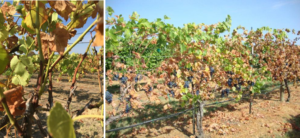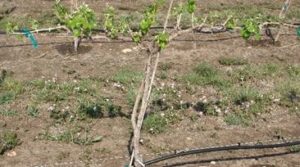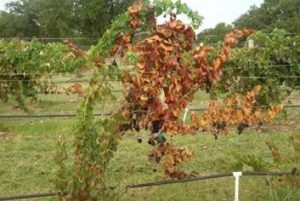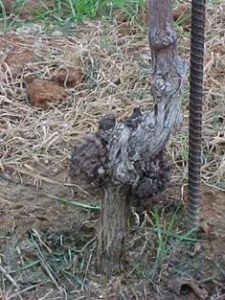by Pierre Helwi, Ph.D. (June 2019)
Soil mineral composition is one of the key components of viticulture terroir. Indeed, mineral elements such as calcium, iron, potassium, and nitrogen are essential for the synthesis of primary metabolites, as well as the production of many secondary metabolites such as phenolic or aromatic compounds.
Among the minerals that grapevines assimilate from the soil, nitrogen (N) is undoubtedly the one that most strongly influences vine growth and vigor and in consequence, fruit composition. Some authors even consider that the availability of N participates in the terroir effect since it is influenced by the soil. For example, vines generally assimilate more N when they are planted on gravelly soil whereas their N status is lower when planted on clay soil.
N requirements by winegrapes are generally estimated to be between 30 and 70 lbs per acre per year depending on the desired vigor and yield. In Texas, the availability of N naturally occurring in the soil is generally low, often making it a limiting nutrient for vegetative growth. At harvest, fruit contains between 10 and 30 lbs of N per acre resulting in exportation from the vineyard. This phenomenon is strongly correlated with the variety and the vigor and is considered to be the minimum amount that must be supplied each year by the soil and/or by fertilization. However, fertilizer additions to soils must be greater than the amount required because N is mobile in the soil and can be lost by leaching. In contrast, high N availability can lead to excessive grapevine vigor resulting in greater canopy management costs, increase the incidence of fungal diseases, and reduced fruit quality. Therefore, it is essential to maintain a non-limiting, but also a non-excessive level of N to produce a quality crop with an economically acceptable yield. The management of vine N status is therefore crucial in grape production.
NITROGEN IN THE SOIL
In the soil, N is present in two forms, organic and inorganic. The vast majority of N is stored in its organic form, in the form of humus (stable and slowly decomposed) or in the form of fresh organic matter. The inorganic or mineral form of N exists mainly in three forms: elemental (N2), nitrate (NO3–) and ammonium (NH4+). From a plant nutritional point of view, NO3– and NH4+ are considered as essential forms. The organic forms of N (humus and fresh organic matter) cannot be assimilated directly by the vine. A mineralization process is essential to make them bioavailable. This step is carried out by the soil microorganisms. It is essential to note that the mineral N is very weakly retained by the soil. In the absence of fertilization, the availability of mineral N for the vines depends on the amount of organic matter stored in the soil and its rate of mineralization. The latter will be more important if the C/N ratio of the organic matter is low, pH close to neutral, the soil is well ventilated and warm and water reserves close to field capacity. Soil N supply is also influenced by irrigation.
Among the many factors influencing vine N status, plant material is predominant. Each variety or even each clone or rootstock has different rates of N assimilation. For example, Cabernet-Sauvignon and Pinot noir are known for their high rate of N assimilation unlike Riesling and Grenache. At the clonal level, Sauvignon blanc clone R3 has a higher assimilation of N compared with Sauvignon CL297.
Cultural practices can also impact N nutrition. It is known that weed cultivation between the rows increases the competition for N between the vine and the weed, thus decreasing the amount of N available for the vine. On the contrary, legumes, often sown as green manure, will enrich the soil with N.
Finally, the climate of the region and the vintage can also influence plant N status since they affect the rate of mineralization of the organic matter.
NITROGEN CYCLE DURING VINE DEVELOPMENT
- Nitrogen reserves
The growth and development of the vine are partly dependent on its mineral reserves, including N, accumulated during the previous season. N reserves are located in the perennial parts of the vine, which are the roots, the trunk, and the shoots and constitute 20 to 40% of the plant annual needs necessary for its growth. At the beginning of the season, N requirements are important to form young organs in the spring. They are mainly taken from reserves formed especially at the end of the previous season before root absorption takes over. Starting at veraison, if N quantities absorbed from the soil remain insufficient, a new phase of remobilization of the reserves will take place.
- Nitrogen absorption
The amount of N taken from the soil varies according to the stage of vine development. Two periods of intense absorption of this nutrient are described: a first period between budbreak and veraison, and a second period after harvest and until leaf fall. The amount of N removed from the soil increases gradually from the 3-5 leaf stage to 50% of the total N content in the pea size stage (first peak of N accumulation). Then, N absorption decreases between veraison and ripeness and increases after the harvest. N quantities absorbed after harvest constitute 30-40% of the total N and will be mainly stored in the trunk.

Dynamics of vine N uptake during the season (adapted from Conradie 1980).
- Transport and remobilization
N is transported in comparable quantities to all vine organs by the xylem, driving the sap rich in water and nutrients from the soil to the leaves, and the phloem driving the sap rich in carbohydrates.
Starting bloom, total N concentration of the shoots increases gradually to reach its maximum level at the end of the vegetative growth. This increase is due to a translocation of this element from the leaves to the shoots and the perennial parts. N content in the aerial parts of the plant (limbs, petioles and berries) reaches its maximum in the early stages of development, concordant with the phase where N uptake peaks, then decreases over the season with minimum values at harvest or in the fall.
- Dynamics and location of nitrogen in the berry
In the berry, a significant allocation of N begins after flowering thus causing a drop in the content of this macro-element in the perennial parts of the plant despite the continuous supply from the roots. Thus, cluster development and N reserve formation seem to be two antagonistic processes. The translocation of N in the grape berry increases gradually during ripening. N is accumulated mainly two weeks before the pea-size stage and then after mid-veraison. During these two periods, the berry accumulates more than 50% of the N present in the plant. At the end of ripeness stage, a large amount of N is transported from the roots to berries.
SYMPTOMS OF NITROGEN DEFICIENCY
- Overall yellowing of lower and older leaves. As deficiency worsens, younger leaves will show symptoms.
- Slow growth, short internode and small leaves.
- Reduction of yield.

Symptoms of N deficiency (Photo courtesy of Fran Pontasch; Texas A&M AgriLife Extension Service).
NITROGEN FERTILIZATION
N fertilization stimulates N metabolism and consequently protein synthesis. Two periods of fertilization are recommended depending on the stage of development and must be reasoned according to indicators of soil and vine N status. The first period is between budbreak and fruit-set, when N uptake and plant needs are at maximum. The second period is the post-harvest stage when reserves for the following season growth are constituted. Small quantities via drip irrigation (5 to 15 lbs N/acre) are recommended at this second period. If N application is made close to leaf fall, uptake will be low and N will be leached through the soil profile. Large applications of N should be avoided in late season to ensure that shoots properly harden off and acclimate for winter.
In vineyards deficient in N, a foliar N supply between flowering and veraison generally increases must available nitrogen (YAN), essential for a better alcoholic fermentation.
Application prior to budbreak is of no value since N uptake is low and the vine is still using N from reserves. In addition, N should not be applied close to flowering as it may result in bunch shatter. Applications around veraison and during ripening should also be avoided as this could promote excess growth and decrease berry quality.
Fertilization is generally accompanied by an increase in leaf area coupled with an increase of chlorophyll synthesis and development of storage tissues such as the trunk, the shoots and the roots.
APPLICATION METHODS
Direct soil surface application – dry N fertilizers are applied directly to the soil surface either by banding in the weed-free strip under the trellis where vine roots are concentrated or by broadcasting over the vineyard floor in clean cultivated vineyards. The disadvantage of such applications is the dependence on rainfall for incorporation and availability. Some growers mix N with their herbicide sprays to enhance herbicide activity and as a source of nutrition.
Fertigation – more efficient technique since N is applied in small amounts at regular intervals rather than large rate all at once as done by direct soil surface application. On sandy soils, multiple applications of small amounts are recommended to reduce the risk of salt injury and to compensate for potentially greater losses of N via leaching.
Foliar application – although having limited benefits, small applications of N in the form of urea may be used to correct visual symptoms of deficiency. With foliar applications, a risk of leaf burn can occur mainly when sprays are done between bloom and harvest.
NITROGEN SOURCES
Dry N for soil surface application – Examples: Urea (46% N), Calcium nitrate (15% N), Potassium nitrate (13% N), Ammonium sulfate (21% N), Monoammonium phosphate (11% N) and Diammonium phosphate (18% N). The N percentage given for fertilizers indicates the percent by weight of N (i.e. 100 lbs of urea (46% N) contains 46 lbs of N).
Liquid N for soil application – Examples: Aqua ammonia (20%), Calcium ammonium nitrate (32%), Urea ammonium nitrate (32%), Urea (23%) and Ammonium nitrate (20%).
If using ammonium form of N, the fertilizer must be incorporated into the soil by tillage or rainfall, otherwise, valuable N may be lost through volatilization.
Complete fertilizers such as 10-10-10 could also be considered.
Manure and other organic matter – slow and long term release of N.
Cover crops – a winter legume such as vetch or clover can be a good N sources and will extend N availability.
VINE NITROGEN STATUS AND ITS EFFECT ON VINE GROWTH AND GRAPE COMPOSITION
The effect of N nutrition on vine growth and berry composition was explicitly described by Bell and Henschke in 2005. In their review, they mentioned that N deficiency, defined by low vigor and a YAN less than 100 mg/L, leads to a decrease in growth and yield as well as yellowing of the leaves. The presence in the must of low concentrations of YAN causes delays or difficulties of fermentation and results in the presence of hydrogen sulfide and/or undesirable sulfur compounds in the wine. This deficiency can be caused by an insufficient availability of mineral N in the soil, but also by a strong water stress which prevents the assimilation of N by the root system. A YAN value close to 200 mg/L is recommended to ensure a smooth running of the fermentation.
In contrast, an excessive N supply causes increased yield, vigor, photosynthetic activity and susceptibility to Botrytis cinerea. Among other things, the excessive vigor alters canopy microclimate, thus resulting in a decrease of temperature and radiation received by the various organs (leaves, buds and clusters). Radiation decrease reduces the concentration of anthocyanins, terpenes and total phenols in the berry. Moreover, the low temperature inside the canopy causes high titratable acidity and a low pH due to an increase in malic acid content. A reduction in temperature can also causes a slower maturation resulting in insufficient phenolic maturity at harvest.
NITROGEN FERTILIZATION IN TEXAS
In Texas, the majority of vineyard soils, particularly sandy soils, are naturally low in organic matter. In consequence, N fertilization seems to be primordial for optimal vine growth and fruit quality. As a mobile nutrient and due to its high leaching rate on these types of soils, N application should be made more frequently adding small doses at each application. A split application between the 3-5 inch leaf stage and fruit-set is recommended with quantities depending on tissue testing and overall vine visual observations. As mentioned previously, attention should be made to the planted variety and the scion/rootstock combination as some cultivars has a tendency to better assimilate N and has the potential of excessive vigor that influences vine health and grape quality.
Pierre Helwi, Ph.D. | Assistant Professor and Extension Viticulture Specialist
Texas A&M AgriLife Extension Service | 1102 E. Drew Street, Lubbock, Texas 79403
Phone: (806) 723-8447
E-mail: pierre.helwi@ag.tamu.edu










